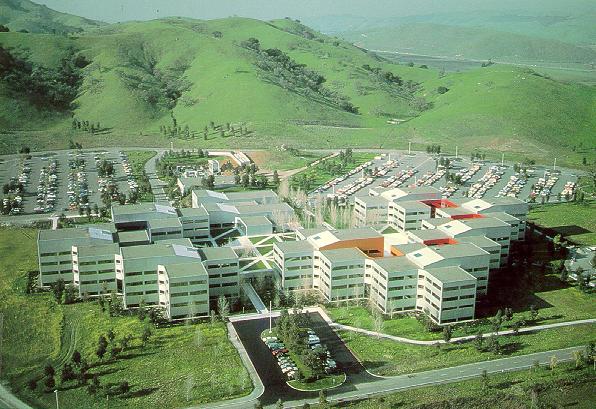IBM Santa Teresa Programming Center
San Jose, California


IBM's Santa Teresa complex is built on a 1,180-acre site in San Jose's foothills, a beautiful natural setting, of which 90 percent is set aside as open space. The facility, designed by MBT Architecture, houses 2,200 persons engaged primarily in computer programming and related services. This large complex solves a long list of seemingly insurmountable problems. These included designing for a beautiful but earthquake prone natural setting; providing a large group of technical people with both extreme efficiency and human comforts; and meeting the highly specialized and demanding requirements of computers.
The campus like facility consists of eight cruciform shaped, four story buildings clustered tightly around a plaza and a 45,000 sf computer center. This center has one of the largest computer capabilities in the world. Support services are extensive and include a library, combination dining and meeting rooms, specialty conference and classrooms, a large reproduction facility, medical facility, employee services, recreation building, and maintenance facility.
The design of an efficient circulation pattern became extremely important once the campus configuration was selected. All buildings are linked beneath a second level, landscaped plaza which is a prime contributor to the non-institutional atmosphere of the complex. Most of the buildings are also linked by bridges at the upper floor levels. The core of each building contains the stairwells, elevators, restrooms, and administrative support centers, and is surrounded by a primary circulation corridor. Radiating from the core are identical wings of private offices and conference and computer terminal rooms.
The clustering pattern of three buildings, offset from the other five, marks the entrance from the visitor parking area and reduces the scale of the complex from the road. This organization opens up vista corridors diagonally and at right angles throughout the complex. Views to the surrounding hills and nearby valley are emphasized architecturally by the pattern of walkways on the plaza level.
Each building is color coded with brilliant colors; magenta, red, red-orange, yellow, green, teal, and blue, for easy building identification. On the exterior, the color coding exists only to where the wings of two structures join to form a courtyard. Therefore, each courtyard has a predetermined, complementary pair of colors. The interiors of the buildings are also completely color coded, from office tackboards to stairwells.
Faced with the challenge of siting a major computer facility in seismically active area, the MBT Architecture team designed the complex to accept earthquake forces determined by seismic analysis of the nearby faults including the immediately adjacent Shannon Fault. The facility utilizes steel frame structures that are highly flexible and capable of moving relatively freely under severe seismic conditions. The design incorporates lightweight, custom aluminum curtain wall panels, with flush glass floating in sealant with no mechanical restraint.
Energy conservation is achieved through exterior heat reflection, daylighting, earth insulation, internal heat recovery and special mechanical system controls. The mirrored glass walls and the burial of the first floor dramatically reduce external heat gain; the immediate proximity of the majority of offices to large windows permits minimum heat gain from lights. All space heating and water heating is by heat recovery from the computers and lighting fixtures. The variable volume system is computer controlled for optimal efficiency.
The development of the project involved rigorous fast tracking. Occupancy of the facility in 1977 occurred less than three years after the request for proposal was sent. The schedule was met, even though the project required such special services as an Environmental Impact Report, master planning, programming, furniture design and art selection, as well as 11 major construction contracts and several dozen minor contracts.
Created: October 15, 1997